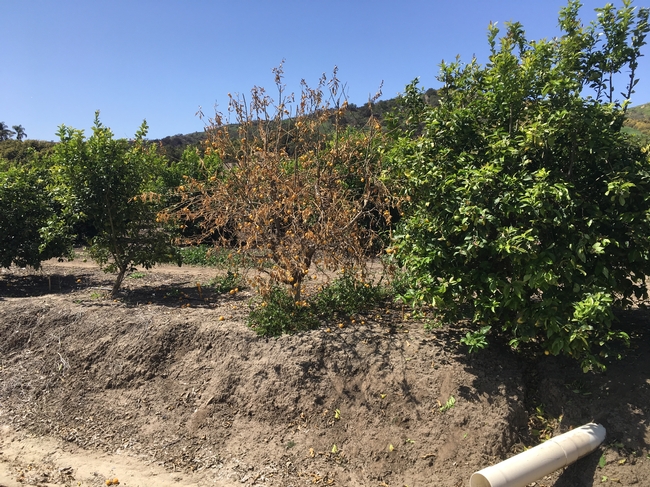Even though it's been a mild winter; other than fire, rain and some cool nights, we did have a few days of hot weather, which is just what sets off citrus dry root rot. It pops up after the first hot weather of the spring, and there it was driving down the road. There's nothing that can be done with this tree. Tree removal and replacement is the answer. Prevention is the solution. We know that Fusarium fungus is usually associated with the collapse, but wounding is the key. Mechanical injury from weed whips, discs, gophers, voles, rabbits. Wounding from salt damage might do it too.
Dry root rot, a disease caused by the soil fungus Fusarium solani, has a long history of hindering production of citrus in California. Fusarium solani is a weak pathogen that infects only when there is some kind of stress in citrus tree. However, presence in almost all citrus orchards everywhere in the world including California, enhance its quick exploitation of such stresses. Some of the factors that are possible stress include invasion by other pathogens, such as Phytophthora and Citrus Tristeza Virus (CTV). Other stresses are wounding by gophers/rodents or insects, girdling, asphyxiation especially drowning the tree with too much water, soil nutrient content and fertilization, irrigation, and other cultural practices in the orchard. The pathogen is an opportunist on citrus. With the stress, Fusarium solani begins infection by colonizing the cortical tissue of feeder roots, advances into the lower tap root and/or scaffold root, and move up through the bud union into the center of the trunk. Studies over the years have shown that many rootstocks are susceptible and old trees as well as young twigs are not spared of the disease.
http://ipm.ucanr.edu/PMG/r107100211.html
//ucanr.edu/blogs/blogcore/postdetail.cfm?postnum=17821
Photo: collapsed tree near and older one on the right, but also near a younger one that probably was a replacement for one that had collapsed several years prior
Attached Images:
